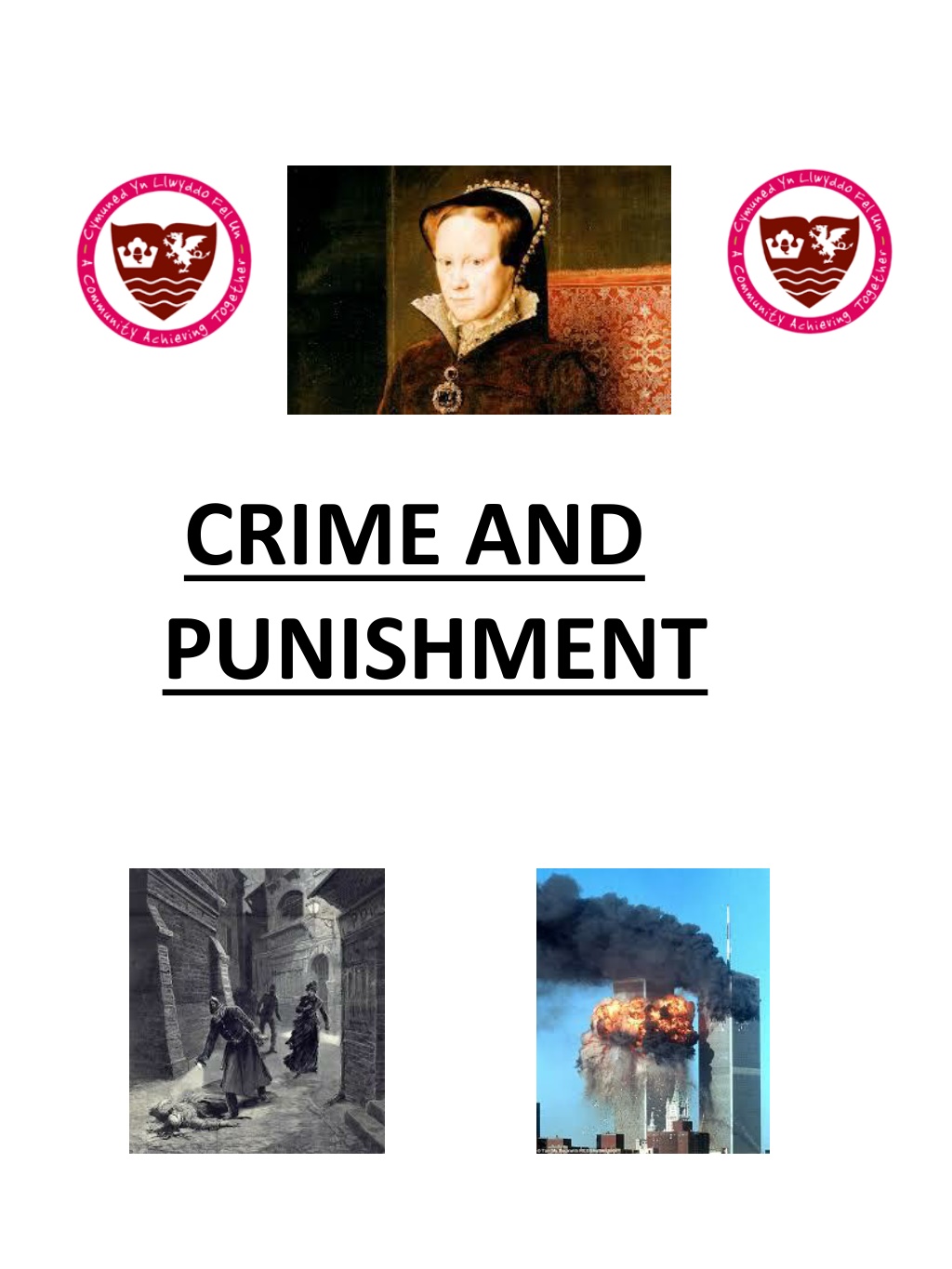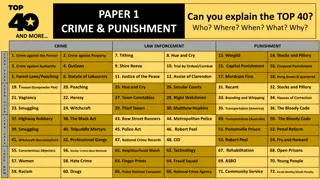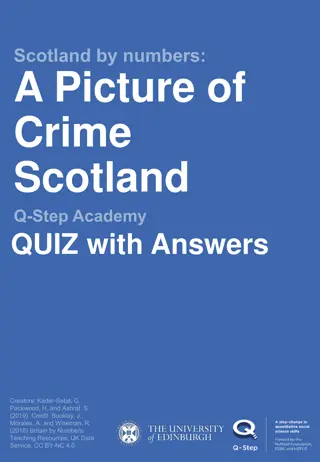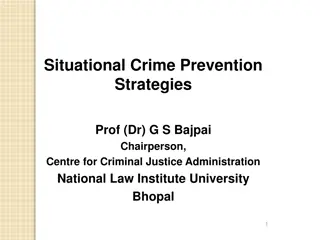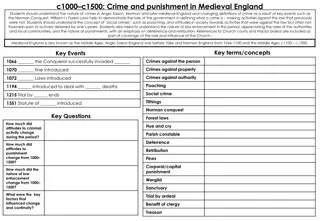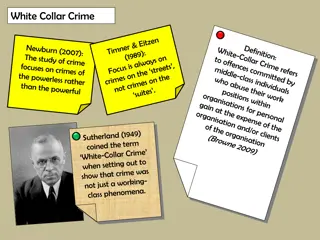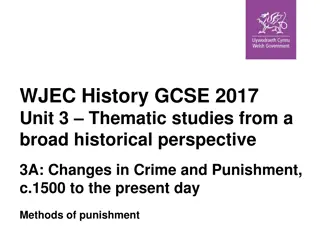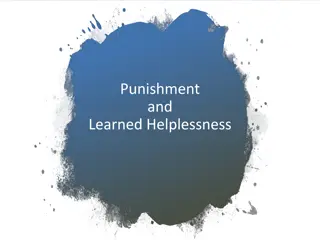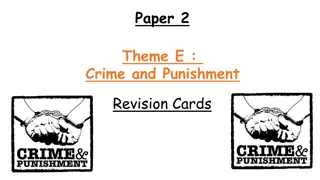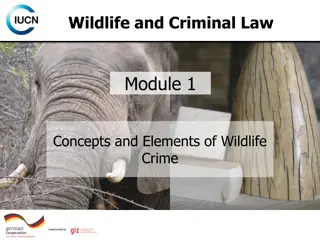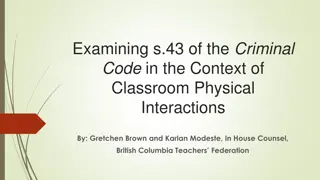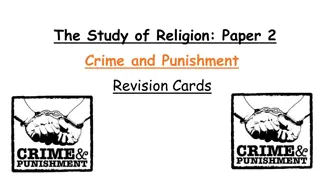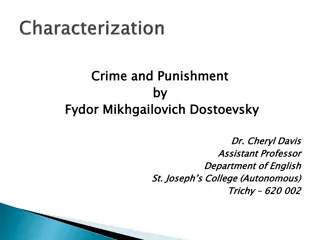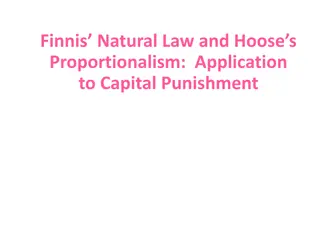Evolution of Crime and Punishment through History
Explore the main causes of crime in England and Wales during the sixteenth and seventeenth centuries, focusing on poverty, heresy, vagrancy, and treason. Discover the impact of religious changes during this time, with shifts between Catholicism and Protestantism leading to significant social unrest. Delve into the effects of industrialization and urbanization on crime rates in the eighteenth and nineteenth centuries, emphasizing the link between poverty and criminal activities.
Download Presentation

Please find below an Image/Link to download the presentation.
The content on the website is provided AS IS for your information and personal use only. It may not be sold, licensed, or shared on other websites without obtaining consent from the author. Download presentation by click this link. If you encounter any issues during the download, it is possible that the publisher has removed the file from their server.
E N D
Presentation Transcript
CRIME AND PUNISHMENT
Question styles for the exams. Crime and Punishment: (1 hour 15 mins) 1) Complete the sentences below with an accurate term [4] 2) Use Sources A, B and C to identify one similarity and one difference in ..[4] 3) Describe ..[6] 4) Describe [6] 5) Explain why ..(PEEL) [12] 6) Explain why .(PEEL) [12] 7) To what extent ..(Essay) [16+4]
What have been the main causes of crime over time? One of the main causes of crime in England and Wales during the sixteenth and seventeenth centuries was POVERTY Heresy: With religion changing so much in the sixteenth century, heresy was a common crime. This was saying or doing something against God and monarch. Vagrancy: Poverty, rural depopulation, unemployment, able- bodied poor, deserving poor, rogues and vagabonds Treason: One of the most serious crimes of the age. This is where you say or do something against the monarch. Causes of poverty: Rising population. By 1550, there were 3,200,000 people in England and Wales. Fifty years later it was 4,200,000. Bad harvests: 1556, 1596 and 1597 were particularly bad with the threat of starvation. Rising inflation: wages couldn t keep pace with rising prices. Fighting costly foreign wars: this meant that the king or queen raised taxes. When sailors and soldiers returned home, there were no jobs for them. Rack renting: landlords kept increasing rent. Many people were evicted. Try this: Explain why vagrancy was such a problem in the sixteenth century. [12] Remember PEEL and use your how-to- guide to help you!
What was the impact of religious changes in the sixteenth and seventeenth centuries? Henry VII: 1485-1509 Catholic Mary I 1553-1558 Catholic Henry VIII: 1509-1547 Catholic, and the Protestant from 1536. Elizabeth I: 1558-1603 Protestant Edward VI: 1547-1553 Protestant Have Welsh example ready for your exam! Find out about Rawlins White, Richard Gwyn and John Penry. Heresy became a common crime in the sixteenth century as the official religion of the country could switch with each new king or queen. Some monarchs took the crime of heresy more seriously than others. Mary I holds the record for most deaths during her reign. She burned many prominent Protestants. Her sister Elizabeth I began her reign by allowing both Catholics and Protestants to worship in peace, however, she soon clamped down of the Catholics. Try this: Describe the crime of heresy and treason in the sixteenth century. [6] Use your how-to-guide to help you answer this type of question.
Industrialisation and Urbanisation of the Eighteenth and Nineteenth Centuries. Again, it is important to note than one of the key causes of crime during this period was POVERTY As in previous periods of time, around 75% of all recorded crime in the eighteenth and nineteenth centuries was theft. Violent crimes made up about 10% of crimes. Murder was relatively rare. Despite this, the people of the big cities, particularly London were still more frightened of gruesome crimes than of petty theft. Most middle class people living in the West end of London believed that the city was in the grip of a crime wave that needed to be stopped. This belief was highlighted by stories in the press. People were particularly interested to read about murders and murderers. Pickpockets: People had been pickpocketing for centuries. However the overcrowded streets of Whitechapel and East London gave pickpockets new and greater opportunities. Big public events provided an excellent opportunity for crime. Riots and Protests: Between 1800 and 1850 there were many protest movements in England and Wales. The public unrest was caused by many social and economic changes which followed the Industrial Revolution. This period saw poorer people protest against the government as they still had no vote or any way to show unhappiness. Rookeries: These were the areas of town where criminals tended to live. They were the areas of poorest housing and narrow streets. (China)
Causes of crime in the 20th and 21st Centuries. The rise of computers and the internet has seen a dramatic rise in new types of crimes. Hacking and phishing are just some of the crimes that can now be committed online. The growth of radical religious fundamentalism across the globe has seen a new type of crime in the 20th and 21st centuries: terrorism. Groups such as ISIS and Al Qaeda have committed atrocities in the name of their cause. Thousands have died and governments have found it difficult to tackle, as such groups often are only small in number. The 9/11 attacks in New York and Washington and the 7/7 bombings in London are two recent examples. Knife crime is becoming a massive problem in Britain today. The police are finding it difficult to deal with as youths think it s acceptable to carry knives in public. Often these youths have no role-models or boundaries set by a family, so join gangs. Thankfully, Britain is a country in which gun crime is still relatively rare. Following the Dunblane massacre of 1996, all handguns were banned in Britain, and even today, purchasing a gun in Britain is very difficult. Gun crime seems to be rising in London and other larger cities. Car crime is a relatively new problem that the police have had to deal with. Invented at the beginning of the twentieth century, car crime gradually became a massive problem in the 1970s and 80s. Carjacking and robberies could be committed with ease and the police struggled to keep pace. Modern cars have much better security, such as immobilisers and steering locks, which has brought a fall in recorded cases. Find Welsh examples: Meibion Glyndwr. Try this: To what extent is crime more prevalent in the twentieth and twenty-first centuries? [16] Use your how-to-guide to help you answer this kind of question.
How has the Nature of crime differed and changed over time? Vagrancy in the Sixteenth Century. Rogues and vagabonds were beggars during the Tudor times. They had no home or job and wandered the country looking for work. Most people in towns were suspicious of vagrants because they travelled in big groups and it was often believed they were up to no good committing crimes such as theft. Why did people become vagrants? The population of the country increased by 40% and there was not enough work for everyone. Henry VIII decided to close down the monasteries because he wanted their wealth. These monasteries previously provided shelter, medical and charitable care for people, and now they were gone. Prices were going up faster than wages, Laws were passed to punish vagabonds. In 1531, a law was passed whereby vagabonds would have a letter V burned onto their foreheads. Smuggling: Smuggling is where you bring goods into the country illegally. During the 17th century, the government raised taxes on many goods, which meant they were cheaper to get from abroad. The only way to get them in to the country was to smuggle them in. Britain s coastline of cliffs and caves made it perfect for smuggling. Most people didn t regard smuggling as a crime and would actively take part for extra money. Smuggling happened all along the coastline of Wales. It s jagged coast was perfect to hide goods. Custom Officials struggled to keep a check as the territory they had to cover was huge. Often the locals would bribe officials to turn a blind eye to smuggling operations along the coast. Try this: Explain why smuggling started to decline in the seventeenth century. [12] Remember PEEL and use your how-to-guide to help you answer this type of question.
Why did Highway Robbery increase in the Eighteenth century? The 18thCentury is often called a golden age for highway robbery. Highwaymen were seen by the authorities as the most serious threat of all to law and order. They threatened the lifeline of towns and the postal service. Large rewards were offered for information that would lead to their arrest. Reality: Many highwaymen were violent and cruel. One, whose mask slipped during a robbery, cut out his victim s tongue. Image: The view of highwaymen is a glamorous one, well-dressed and daring. They were polite to victims and rarely used violence. Why did Highway Robbery increase? More roads were built; More traffic on the roads; There were no banks, so you carried your money with you; Roads at night were quiet so robbers could get away with their crimes; They could make a fast getaway on horseback; The availability of cheap pistols. Have Welsh examples ready! Find out about smuggling in West Wales, Gower and Cardigan Bay. The most famous of all highwaymen was Dick Turpin. Born in Essex, he became a butcher s apprentice and married a local woman. But he was not happy with a poor life and he wanted better. He turned to horse stealing, house breaking and theft. He then turned to highway robbery. He was caught and hanged in York in 1739. He died to the cheers of the public who admired him. Try this: Explain why the problem of highway robbery increased during the eighteenth century. [12] Use PEEL and your how-to-guide to help you answer this question.
What types of industrial and agrarian disorder was there during the Industrial Revolution? The Luddites: In the 18th and early 19th century, although it had a parliament, Britain was not a democracy. That meant that the only way people could show displeasure with the government was through violent protest. There were riots in Nottinghamshire, Yorkshire and Lancashire by hand- weavers who broke into the factories to destroy the new machines. There was a mass trial at York in 1813 after which 17 Luddites were executed. The crisis was made worse by food shortages. The Luddites were an effective force and successful in their protests. The Tolpuddle Martyrs: The Tolpuddle Martyrs brought about the beginning of the modern trade union movement. The farm workers wanted to protest against their poor pay and working conditions. As a result of their actions, six were transported to Australia. The Trade Union Movement ensured their families had enough money to survive whilst they were away. A petition of 800,000 signatures was organised and the men were freed in 1836. Since then, the trade unions have grown, protect employees to this day and represent them regarding pay and working conditions. Try this: Describe how serious Industrial disorder was during the Industrial Revolution. [6] Use your how-to-guide to help you answer this question. Find Welsh examples: The Chartist protests in Llanidloes and Newport in 1839 and the Rebecca Rioters.
Chartists, Swing and Rebecca Riots Chartists: The Chartists organised huge rallies and petitions to parliament in the 1840s to campaign for political reform. Although there was a Chartist riot in Newport in 1839, Britain avoided a full scale revolution. The Chartists wanted: a vote for all men, a secret ballot, payment for MPs, electoral districts of equal size. The Peterloo Massacre occurred in Manchester when cavalry charged a crowd of 80,000. The crowd was forced to disperse. Swing Riots: These attacks were on farm machines all over the South of England. 2,000 people were put on trial of whom 19 were executed. Labourers would destroy machines that cost a fortune to repair. They particularly targeted the new thresher machines that they said was taking away their jobs. Such criminal damage was common at the time until gradually the government accepted that it was its duty to act in the interests of the people. Rebecca Riots: In 1750, getting around Wales was very difficult. Most roads were owned by turnpike trusts, whereby you had to pay at a toll-gate in order to use the roads. Welsh farmers needed the roads more than most and resented having to pay. There then began examples of the toll gates being smashed up and destroyed at night by men dressed as women. The trust would then rebuild the gate only for it to be destroyed again. Eventually the gates were not rebuilt.
How did civic and parish responsibility grow in the sixteenth century? Justices of the Peace: Before 1829, there was no police force in Britain at all. However, there were people who s job it was to keep law and order . Britain s towns and villages were policed by three groups of people who all had to work together to fight crime. Justices of the Peace were usually wealthy landowners who volunteered for the role. They had to police alehouses, arrest vagrants, and sentence criminals to the stocks or the pillory. Humiliation was the key to Tudor law and order. Constables: These men were appointed by the JP and were not paid or legally trained. They were forced to hold the job for one year. If they refused, they faced a large fine. Constables were usually working class people who had a full time job as well as being forced to police the streets. They would make arrests and carry out the punishments handed down by the JP. Watchmen: The lowliest form of policing, usually done by older men. These people were paid, only because nobody else would do it. Watchmen had to keep watch on the streets at night and each hour would call out the time and shout All is well! They had a specific beat to patrol. Try this: How effective was the Tudor system of maintaining law and order? [16] Use your how-to-guide to help you answer this type of question.
Methods of combatting crime: How effective were JPs, constables and watchmen? In the Tudor times, the JP was elevated in rank above the constables, watchmen and even the local sheriff. JPs had huge power and to be chosen for the role was a great honour. They had four main responsibilities: To maintain law and order; To administer local government; To carry out the orders of the Privy Council; To supervise the work of other law officers. Merthyr Tydfil had a population of 30,000 but only 2 JPs keeping law and order. It was clear that a new approach would soon be needed. With the growth of the urban population in the seventeenth and eighteenth centuries, the role of the JP became increasingly burdensome and the workload was simply too much. The parish constable had the responsibility of helping the JP keep law and order. The office first appeared in 1250 and remained virtually unchanged for hundreds of years after. The constable was expected to call the hue and cry if they needed assistance and it was the duty of local residents to go and help. The Act of Union of 1536 brought Wales under English legal jurisdiction. A system going back several centuries was replaced with the English system of JPs. It soon became a position of great status and was highly sought after by local landowners and gentry. The role of watchman was unpopular as it was unpaid and when coupled with a day job, it could be very cumbersome and time consuming. Watchmen patrolled the streets at night ensuring the towns and cities were safe.
The concept of a police force in the nineteenth century. The Bow Street Runners. Until the 19th century, enforcing the law continued to be the responsibility of Justices of the Peace. JPs were assisted by constables and watchmen who did a very poor job. By 1750, London had grown to a city of 500,000 people and crime was a serious problem. In 1748, Henry Fielding was a magistrate at Bow Street Court. According to Fielding and his half blind brother John, only 6 of the 80 constables were any good. He persuaded the good men to stay and he hired 80 more to try and break up some of London s criminal gangs. They were paid for their duty and were expected to keep a detailed record of crime and criminals. After Fielding retired in 1754, his brother John took over and Bow Street had an efficient, trained and paid force of constables. They took on the name Bow Street Runners. It was said that John Fielding could recognise the voices of over 3,000 criminals. Positive points about the Bow Street Runners: They were professional and were paid, They kept detailed records, Fielding brothers came up with preventative methods to stop crime. Negative points: Only focused on London.
Sir Robert Peel and the creation of the Metropolitan Police. There was considerable opposition to the creation of a police force. However, the success of the Bow Street Runners and rising populations meant that change was needed In 1822, Sir Robert Peel became Home Secretary, with his main responsibility being law and order. He felt some of the existing forces were ineffective and managed to persuade the Prime Minister, the Duke of Wellington, that a London-wide police force was needed under the control of the Home Secretary. The result was the Metropolitan Police Act of 1829. Two commissioners were appointed to oversee the day-to-day running of the force. The new force set up its HQ at Scotland Yard and divided London into 17 districts, each with a force of 144 constables and a superintendent to oversee them. Within a year, the force was fully manned with officers having to be less than 35 years old, at least 5 7 tall and be able to read and write. Constables were required to work seven days a week and patrol a beat. Uniforms were blue and officers were supplied with a wooden truncheon. Try this: What does the photo tell you about the policing in London in the 1850s? The creation of police forces across the country took several decades to achieve. The Rural Police Act of 1839 allowed JPs to set up police forces in their own counties. The act was NOT compulsory and many areas refused to entertain the idea of a force in their area. During the 1840s, 5 of the 13 counties of Wales had their own force. By 1856, all counties had one.
The changing nature and purpose of the police in the twentieth century. Since the beginning of the twentieth century, the police force has undergone many changes, not least in technology and methods of detection. Some aspects of the police have remained the same though. Their duties remain to deal with minor and major crimes and to maintain public order. The police hold specific powers to carry out their job, for example: The power to arrest you; The power to search you; The power to detain you; and The power to fine/report you. Since its earliest days, policing in Britain has been based on a community based model. The introduction of Neighbourhood Watch schemes and Police Support Officers has attempted to make the police more locally based again. Some forces are huge and that community feeling is lost. The attitude of the British public towards the police has altered over the previous two centuries. They were initially viewed with suspicion, as the police in France were often used by the government as spies. There was the cost issue and invasion of privacy that affected views too. Gradually, the police came to be respected as a force for good in reducing crime. Isolated incidents over the decades have tended to tarnish their reputation, however, generally the British people have a favourable attitude to them. Try this: Explain why methods of law enforcement underwent change during the second half of the twentieth century. [12] Use your how-to-guide to help you. New technology has massively helped the police carry out their duties. CCTV is now everywhere in Britain and advanced in DNA and forensic science can detect criminals quickly. Radios, computers and the internet are now all used to help in the fight against crime.
Developments in policing in the Twentieth Century. In 1919 the very first female police officers appeared. They were not allowed to carry handcuffs or make arrests and were given the prefix WPC (Woman police constable) before their name. It was not until the 1970s that women were fully integrated into the force and today the number of female officers stands at 30%. The biggest change in policing over the twentieth century has been in transport. Patrol cars, bikes, horses and helicopters are used to help in the fight against crime. Some forces now have drones to assist them. Aerial units can be on the scene of an incident before those on the ground arrive. Try this: Why have developments in transport been important in policing methods during the twentieth and twenty-first centuries? [16] Use your how-to-guide to help you answer this.
Attitudes towards punishment: Why do we punish criminals? Why does society punish those who commit crime? To discipline, to deter, to protect and to reform. Capital punishment involves executing the criminal in the hope that it deters others from copying their crimes. At one point there were 225 crimes that you could be put to death for in Britain, known as the Bloody Code. Public opinion in favour of capital punishment was high and newspapers regularly reported on the notion that crime was too high and needed to be controlled. Eventually public opinion for executions wavered and faded. Many of the old medieval methods of punishments continued to be used in this country up until the 1600s. The idea was to use corporal punishment, ie. inflicting pain on an individual to stop them from repeating the crime. The stocks and the pillory were a common form of punishment during this time. The idea was to humiliate offenders in front of the townsfolk to prevent reoffending. The pillory and stocks were in use in Britain up until the 1870s. An act of 1948, finally ended all kinds of corporal punishment in Britain. The last hanging in Wales was a murderer, Robert Coe in Swansea in 1866. Executions by then were taking place in prison away from public gaze.
The use of banishment and transportation in the eighteenth and nineteenth centuries. This era saw a growing realisation that the Bloody Code was too harsh. An alternative punishment, still severe, and that was transportation to Australia. By 1783, some public executions were getting out of control. The crowd was unruly and pickpockets were everywhere preying on the crowd. Attitudes towards brutal, extreme punishments was changing and transportation became an alternative between the extremes of hanging and the lesser whipping or flogging. It was hoped that the criminals who were transported would have chance to learn new skills and to begin a new life without the need to resort to crime. By the early 1800s, some juries refused to allow criminals to be executed as they felt that the Bloody Code was far too severe and needed to be abolished. Home Secretary Robert Peel believed the code to be savage and campaigned to have the code reduced to just 5 crimes to which you could be executed.
The use of prison to punish and reform in the nineteenth century. By the 1800s, prisons played a tiny part in the criminal justice system, but by the 1860s, 90% of all criminals were placed into the system. In the 1800s, the focus of the criminal justice system had shifted towards reforming the criminal, rather than punishment or humiliation. Prison reform accelerated during this time for a number of reasons. Firstly, the influence of notable prison reformers, such as Elizabeth Fry and John Howard made great efforts to initiate change. Transportation as a punishment was seen as inhumane and was coming to an end. There were changes in public and government attitudes towards how to deal with prisoners. Finally there were many public debates on how to treat prisoners, with a mind to reform them rather than get rid of them. The 1800s saw a major debate over how to treat prisoners: do we reform them, or punish them? The Separate System believed that criminals were bad because they were exposed to wicked influences. If they could be separated from others and given chance to work they could be reformed. The alternative was the Silent System, where prisoners could only be broken through strict and tough discipline. Boring, monotonous tasks were designed to punish the criminal whilst in prison. The debate was unique in Britain in deciding which was best: punish or reform? The Gaols Act of 1823 marked the start of the reform of prisons; Pentonville Prison in London is the best example of the separate system. Borstals introduced in 1902; Open Prisons set up in 1932 to house non violet, low risk prisoners; Parole, probation, community service.
Changes in attitudes towards punishment in the twentieth century. The Gladstone Report of 1895 finally showed a swing in public opinion away from harsh punishments and in favour of reform. The Silent System was phased out and attitudes towards punishment evolved. Dealing with youth offenders rapidly evolved in the twentieth century. The use of borstals, run like boarding schools with strict discipline were introduced in the early 1900s to house offenders. Borstals evolved into the modern Young Offender Institutes for juveniles. Electronic tagging and ASBOs are now common too as a way of dealing with the younger generations rather than sending them to prison. A number of miscarriages of justice in the 1950s and 1960s saw the debate over the death penalty rise again. Some members of the public saw it as barbaric, whilst others saw it as a necessary deterrent. Eventually the death penalty was abolished in Britain in 1967.
Methods of Punishment: The treatment of vagabonds in Tudor times. High levels of unemployment and the religious changes of the Tudor times brought about a rise in crime. Punishments tended to be harsh and humiliating. Tudor England and Wales saw a growth in wandering beggars and thieves moving from town to town. These beggars caused a nuisance to townsfolk and the JPs were often inundated with work to try and stop them. The most coming form of punishment for beggars and vagrants was whipping or flogging in public to try and deter them from further crime. The stocks and pillory were designed for public disgrace and humiliation. Most villages had them. Most Welsh towns had them, indeed the stocks at Denbigh are still on display today.
Methods of Punishment: Transportation Originally seen as a quick alternative to the problem of overcrowded prisons, the British system of transportation involved sending prisoners to America or Australia. It was an alternative to hanging. * It was believed hard work would be beneficial. Reasons for Transportation It would reduce crime by banishing the criminals. * A fresh start for the criminal. * It helps Britain colonise abroad. Prison was too costly. Originally, prisoners were sent to the West Indies or Virginia in America. However, the outbreak of the American War of Independence in the 1770s meant prisoners could no longer be sent there. There result was massive overcrowding in Britain s prisons. The other alternative was Australia. At the height of the nineteenth century five ships a year were heading over to Australia with convicts. In all, over 160,000 people were sent to Australia as punishment before it was abolished.
Prisons and Prison Reform Prisons were originally used as a place to hold people awaiting trial. Gradually they came to be part of the punishment system itself. John Howard: 1726-1790 As a youngster he was captured by French pirates and sent to prison. This had a lasting effect on him. Later in life he became High Sheriff of Bedfordshire, in charge of the county jails. He was so shocked at the state of the jail, he decided to visit others around the country. He recommended prisoners not be kept in confinement and should receive regular visitors. Elizabeth Fry: 1780-1845 After Sir George Paul had highlighted the need for male and female prisoners to be separated, this was taken a stage further by Elizabeth Fry. In 1813, she visited Newgate prison and was horrified at what she saw. She was convinced women prisoners needed education, discipline, hard work and religion. She travelled the country gaining support for her ideas. Thanks to Fry, the conditions at Newgate prison were greatly improved.
